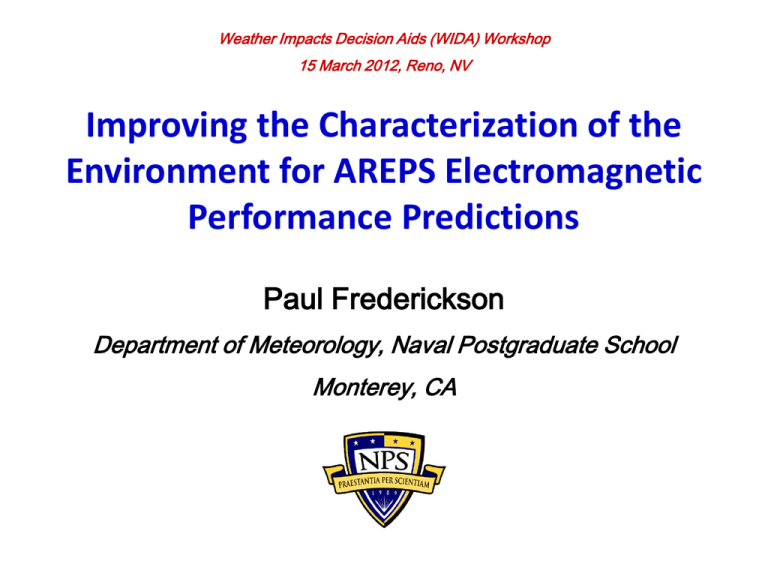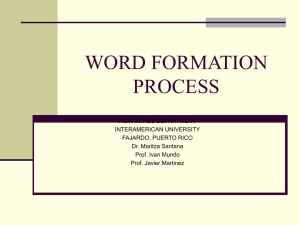Presentation
advertisement

Weather Impacts Decision Aids (WIDA) Workshop 15 March 2012, Reno, NV Improving the Characterization of the Environment for AREPS Electromagnetic Performance Predictions Paul Frederickson Department of Meteorology, Naval Postgraduate School Monterey, CA OBJECTIVE More accurate Advanced Refractive Effects Prediction System (AREPS) electromagnetic (EM) propagation predictions through improved characterization of the environment, to be accomplished through the following tasks: 1) Incorporate a new Navy Atmospheric Vertical Surface Layer Model (NAVSLaM) version with improved performance in stable conditions into AREPS. 2) Incorporate the NPS vertical refractivity profile blending algorithm into AREPS. 3) Replace the old Historical Electromagnetic Propagation Conditions (HEPC) datasets with vastly improved NPS EM climatology datasets & methods within AREPS. 4) Improved access to and use of COAMPS® data by AREPS. Requirements and Capabilities More accurate Battlespace on Demand (BonD) Tier 2 EM system performance TDAs and guidance products being provided to the Navy and DoD warfighter for: • Radar detection of periscopes, missiles, low-fliers, small boats, and other targets. • Radar counter-detection of our own submarines, NSW platforms and other platforms. • Effectiveness of electronic attack, surveillance, communications, any propagation operations. Performers Naval Postgraduate School (NPS): Paul Frederickson, Peter Guest, Tom Murphree Naval Research Laboratory, Monterey (NRL-MRY): John Cook, Michael Frost and Tracy Haack SPAWAR Systems Center, Pacific (SSC-Pac): Amalia Barrios, Gary Lindem and others Impact of Different Ducting Types on EM Propagation Different duct types have distinct impacts on EM propagation near the surface which are highly dependent upon the duct attributes (duct height, trapping layer thickness and strength, etc.), so we have to get the environment right! Propagation loss coverage diagram examples are for a 6 GHz radar at typical shipboard height above the surface. Impact of the Evaporation Duct Height on Radar Detection Ranges • Examples shown are for radars of different frequencies at a typical shipboard mast height and for small and medium-sized surface targets. • The impact of the evaporation duct height on radar detection ranges can be very strong, depending upon the radar frequency and height and the target type, demonstrating that it is critical to correctly take the evaporation duct into account. Note the different range scales in these two figures. Incorporating the new Navy Atmospheric Vertical Surface-Layer Model (NAVSLaM) version with improved performance in stable conditions into AREPS NAVSLaM Performance in Stable Conditions • NAVSLaM is highly dependent upon the empirically-determined Monin-Obukhov Similarity Theory dimensionless profile functions in stable conditions (ASTD > 0). • NAVSLaM is much less sensitive to input parameters and has a much wider region of applicability over which EDH can be defined in stable conditions when using the two new candidate functions, especially the Grachev et al (2007) functions on the right. Evaporation Duct Height (m) Existing NAVSLaM Function Candidate NAVSLaM Functions Greatly reduced sensitivity & wider model applicability High sensitivity to input data and limited model applicability Air-Sea Temp Difference (°C) Air-Sea Temp Difference (°C) Air-Sea Temp Difference (°C) Validating the New NAVSLaM Model Versions Validate the new NAVSLaM versions and compare with the old, using concurrent met & propagation measurements from the Wallops Island, VA, experiment of 2000. X Band S&C Bands NPS Buoy (Met data for input to NAVSLaM) MPMS Shore Station (Receivers) NSWC-DD EM prop data in S/C/X bands (J. Stapleton et al) R/V Sealion (Transmitters in S, C & X bands) NAVSLaM Model Validation: Strongly Stable Case • Moderately stable with low humidity: ASTD = 3.2 °C, RH = 62%, WS = 5.3 m/s. • Current NAVSLaM using Beljaars & Holtslag functions cannot define the EDH. • NAVSLaM with Cheng & Brutsaert & Grachev produce high & very different EDH’s. Current NAVSLaM cannot define the EDH EDH = 63.7 m (209 ft) EDH = 46.3 m (152 ft) Modified refractivity profiles were computed by NAVSLaM using different Ψ functions and then input to APM for propagation predictions. NAVSLaM Model Validation: Strongly Stable Case • S-band example • ASTD = 3.2 °C, RH = 62%, WS = 5.3 m/s. • Current NAVSLaM cannot define the EDH, so no propagation loss results could be produced by APM. • New NAVSLaM with Grachev et al functions produces best agreement with propagation measurements. • Further NAVSLaM validation is continuing. • Results so far indicate the new NAVSLaM version should replace the old in OAML as soon as practicable. Will begin this process later this FY. Propagation Observations NAVSLaM (Cheng & Brutsaert) NAVSLaM (Grachev et al) Incorporating the NPS Vertical Refractivity Profile Blending Algorithm into AREPS Blending Upper-Air & Surface-Layer Refractivity Profiles • NAVSLaM is used to most accurately characterize the evaporation duct using COAMPS® or climatological near-surface data as input. • The NAVSLaM surface-layer refractivity profile must be realistically blended with the COAMPS® or climatology upper-air profiles for accurate EM propagation predictions. NAVSLaM Blended Height COAMPS® or climo Height + = Note that the evap duct ‘fills in’ the skip zone Example propagation loss coverage diagrams are for a 6 GHz radar at a typical shipboard height above the surface. Existing AREPS Profile Blending Versus NPS Blending • Currently when using COAMPS® data AREPS either ignores the evaporation duct or appends a Paulus-Jeske evaporation duct profile below the lowest model level, which creates both an unrealistic ‘kink’ in the refractivity profile and an artificial evap duct. EDH = 55 m EDH = 33 m (Note ‘kink’) NPS Vertical Refractivity Profile Blending Algorithm Blends NAVSLaM surface-layer modified refractivity (M) profile smoothly onto the bottom of a COAMPS® or climatological upper-air refractivity profile. Height Above Surface COAMPS® NAVSLaM Blended NPS Blending Method • Algorithm smoothly blends profiles together and does not introduce erroneous refractivity features (‘kinks’). • Blending interval heights chosen so as COAMPS M slope not to distort either the NAVSLaM or COAMPS® significant refractivity features, as much as possible. • Below blending interval, blended profile Blending Interval NAVSLaM M slope shape is equal to NAVSLaM profile. • Within blending interval, blended profile smoothly transitions from slope of NAVSLaM profile at bottom of interval, and slope of COAMPS® profile at top of interval. • Above blending interval, blended profile is equal to COAMPS® profile. Modified Refractivity (M) NPS Vertical Refractivity Profile Blending Algorithm Common Ocean Unstable Case • Choose point farther offshore of Virginia with unstable conditions. Coastal-Influenced Stable Case • Choose point near shore with offshore advection of warm air and stable conditions. NPS Vertical Refractivity Profile Blending Algorithm Common Ocean Unstable Case • Near-standard COAMPS® profile above sfc. • Blended between 35-50 m, well above EDH (18 m), so no distortion of EDH possible. • Very smooth transition between profiles. Coastal-Influenced Stable Case • Blended profile departs dramatically from COAMPS® if same blending interval is used. • COAMPS® has full 3-D physics for such situations, so preserve COAMPS® profile. COAMPS NAVSLaM NPS Blended Blending Interval EDH If same blending Interval is used NPS Vertical Refractivity Profile Blending Algorithm Common Ocean Unstable Case • Near-standard COAMPS® profile above sfc. • Blended between 35-50 m, well above EDH (18 m), so no distortion of EDH possible. • Very smooth transition between profiles. Coastal-Influenced Stable Case • Use blending interval that smoothes nearsurface portion of profile and also preserves the COAMPS® deep surfacebased trapping layer. COAMPS NAVSLaM NPS Blended Blending Interval EDH Blending Interval Interactive Blending Capability for AREPS? • NPS refractivity profile blending algorithm will be incorporated into AREPS to automatically blend upper-air and surface-layer refractivity profiles. • NPS has developed an interactive GUI which can be incorporated into AREPS to allow the user to examine and change, if necessary, the vertical blending intervals to best fit the specific upper-air and surface-layer refractivity conditions. } } Selected Blending Interval The user can easily change the vertical blending levels to best fit the specific situation Can AG’s be trained to do this accurately and quickly? Incorporating the New NPS EM Climatology Data Sets into AREPS to Replace HEPC Evaporation Duct Climatology Upper-Air Duct Climatology Comparison of HEPC & New NPS Evap Duct Climatology Existing HEPC Climatology Now in AREPS New NPS Climatology Going into AREPS • Based on ICOADS (mainly volunteer observing ships) data for 1970-84. • Based on NCEP CFSR Reanalysis data for 19792010, results in much better statistics. • Computed by outdated Paulus-Jeske ED model which over-predicts EDH in most situations. • Computed by modern NAVSLaM ED model with much improved performance. • Very coarse 10° x 10° Marsden Square averages for spatial resolution and day/night only temporal resolution. • ~0.3125° (~35 km) grid spatial resolution and hourly temporal resolution, important for resolving coastal regions and diurnal variations. HEPC does not provide map views. This figure was produced by NPS for comparison purposes only. EDH = 17.9 m EDH = 13.8 m Comparison of Impact of HEPC & NPS Evap Duct Climos • Scenario is a typical shipboard X-band search radar looking for a small near-surface target in the East China Sea in October at 12Z. • New NPS ED climatology results in a predicted radar detection range of 14.4 nmi. • Old HEPC ED climatology results in a predicted radar detection range of 6.3 nmi. 8.1 nmi New NPS climatology results in a 8.1 nmi greater detection range than HEPC for this Xband example. Evaporation Duct Climatology Propagation Predictions • User selects grid point, month and time of day of interest to obtain an EDH histogram and ‘climatological’ refractivity profiles for 5th, 10th, 25th, 50th, 75th, 90th or 95th EDH percentiles. • AREPS has only a ‘mean’ refractivity profile, with an EDH that does not match HEPC. • Climatological refractivity profiles are input to AREPS for EM performance predictions. User clicks on grid point to create histogram and AREPS ‘ENV’ input file for EM system performance predictions AREPS ENV File Radar Probability of Detection Median EDH = 13.8 m EDH = 13.8 m Refractivity Profile EDH Histogram 22 NPS Upper-Air Ducting Climatology • The NPS Upper-Air Ducting Climatology was computed from the Integrated Global Radiosonde Archive (IGRA) data base using data from 1971 to 2010. • IGRA radiosonde stations with sufficient number of soundings with valid refractivity data are shown for the northern Indian Ocean and western North Pacific Ocean. Compare the NPS and HEPC upper-air ducting climatologies for the Kuwait Airport to demonstrate their differences in the following slides. Atmospheric Duct Types and EM Propagation Impacts • The old HEPC upper-air ducting climatology now in AREPS does not distinguish surface & surface-based ducts and combines them together into the same statistics. • The NPS upper-air ducting climatology treats all these distinct duct types separately. AREPS combines these, NPS treats separately Propagation loss coverage diagram examples are for a 6 GHz radar at typical shipboard height above the surface. Comparison of NPS & HEPC Upper-Air Ducting Climatologies • HEPC data from 1966-69 & 1973-74; NPS data from 1971-2010: much better statistics. Kuwait example: HEPC 7-58 raobs versus NPS 650-842 raobs per month/launch time. • HEPC greatly overestimates occurrence of surface-based ducts due to combining duct types. Kuwait example for April 12Z: HEPC 38% occurrence versus NPS 0.9% occurrence. • HEPC greatly underestimates surface-based duct top heights and thicknesses. Kuwait example for October: HEPC 36 m versus NPS 273-280 m. • HEPC combines 00Z/12Z soundings in statistics; NPS gives separate statistics for 00Z & 12Z. • HEPC only provides medians; NPS provides 5, 10, 25, 50, 75, 90 & 95th percentiles. Old HEPC Climatology New NPS Climatology Comparison of HEPC & NPS Upper-Air Climo’s • Scenario is a shipboard X-band search radar looking for a small surface target off the coast of Kuwait in October at 12Z. • New NPS UA climatology results in a predicted radar detection range of 8.7 nmi. • Old HEPC UA climatology results in a predicted radar detection range of 52.1 nmi. New NPS climatology results in a 43.4 nmi lower detection range. Improved Access to and Use of COAMPS® Predicted Data by AREPS COAMPS-OS® Interface from NEP-Oc (NRL-MRY improving this part) HPAC/AREPS AREPS Environment Creator Window for Ingesting COAMPS® Data (SSC-Pac improving this part) Interpolation of COAMPS® Refractivity Profiles • Refractivity profiles are originally computed for the COAMPS® model grid, which is defined according to a regular spacing on the particular map projection being used for the model run. Interpolation of COAMPS® Refractivity Profiles • In the HPAC data files refractivity profiles are interpolated from the COAMPS® model grid to a regular lat-lon grid. Interpolation of COAMPS® Refractivity Profiles • Refractivity profiles are interpolated again within AREPS to form a rangedependent refractivity environment along a specified path. Refractivity profiles therefore currently undergo two interpolations before being used for EM propagation calculations in AREPS. Impact of Interpolating Refractivity Profiles • In this idealized example to illustrate the impacts of interpolating refractivity profiles, a trapping layer is increasing with height between two adjacent COAMPS® model grid points. Trapping layer increasing in height between grid points Impact of Interpolating M Profiles • Currently, HPAC files are constructed by interpolating vertical refractivity profiles between grid points by COAMPS® height levels. • This can have the undesirable effect of ‘smoothing’ trapping layers, which can very adversely affect EM propagation predictions. The current interpolation scheme results in unrealistic propagation predictions Top & bottom of trapping layer are ‘smoothed’ by interpolation Impact of Interpolating M Profiles • A more realistic method of interpolating refractivity profiles would be to interpolate by duct attributes (i.e. duct height, duct thickness, etc.). • This results in a much more realistic refractivity profile and EM propagation prediction, as shown in green below. New interpolation results in much more realistic propagation loss predictions Trapping layer not smoothed with interpolation by duct attributes Solution for Providing COAMPS® Data to AREPS • New solution is to perform no interpolation of refractivity profiles when constructing range-dependent refractivity environment from gridded COAMPS® data. • COAMPS® profile data will be provided from FNMOC to AREPS users in the native COAMPS grid (i.e. no interpolation to a regular lat-lon grid as done now). NRL-MRY (Cook, Frost, Haack). • When specifying a rangedependent refractivity environment, AREPS will use the M profile from the closest raw COAMPS® model grid-point within a specified distance threshold and apply it to the nearest point along the propagation path. SSC-Pac (Barrios) COAMPS® native grid points Propagation path being modeled by AREPS Refractivity Structure Matching Algorithm (RSMA) • The Advanced Propagation Model (APM) within AREPS requires refractivity profile information at each Parabolic Equation (PE) range step (approximately 270-900 m). • Currently, refractivity profiles are linearly interpolated by height level indices in APM (see left panel below), which distorts and ‘smooth’s out important refractivity features. • NPS, SSC-Pac and NRL-MRY are proposing to jointly develop a new Refractivity Structure Matching Algorithm (RSMA) in FY13 which will linearly interpolate refractivity profiles by their trapping-layer features, as shown in red on right. No RSMA: Trapping layers are distorted and ‘smoothed out’ by interpolation. RSMA: Trapping layers vary linearly with range and sharp edges are preserved. Summary 1) The new Navy Atmospheric Vertical Surface Layer Model (NAVSLaM) version with much improved performance in stable conditions is being incorporated into AREPS now. New model version will be submitted to OAML this FY. 2) Beta-version of NPS vertical refractivity profile blending algorithm code is being incorporated into AREPS while the algorithm undergoes further refinement, validation and testing. 3) New and vastly improved NPS upper-air and evaporation duct climatological datasets and methods are being incorporated into AREPS. These datasets will also be submitted to OAML this FY. 4) New methods of providing COAMPS® data to AREPS and for using data within AREPS are being developed by NRL-Monterey and SSC-Pac to correct interpolation problems and enable use of higher resolution data. 5) NPS, SSC-Pac and NRL-MRY have jointly proposed to develop a new Refractivity Structure Matching Algorithm (RSMA) to correct the last refractivity profile interpolation problem within APM. Questions? Summary 1) A new version of the Navy Atmospheric Vertical Surface Layer Model (NAVSLaM) has been developed with much improved performance in stable conditions. The new model code has been provided to SSC-Pacific for incorporation into AREPS, while the algorithm undergoes further validation. The process of submitting the new model version into OAML will begin this FY. 2) A beta-version of the NPS vertical refractivity profile blending algorithm code has been provided to SSC-Pacific for incorporation into AREPS, while the algorithm undergoes further validation and testing. The process of submitting this algorithm into OAML will begin this FY or next depending upon progress. 3) New NPS upper-air and evaporation duct climatological datasets and tools are being produced, and sample datasets have been provided to SSC-Pacific for incorporation into AREPS. Final datasets and tools will be provided to SSC-Pacific by early May. The process of submitting these datasets into OAML will begin this FY. 4) A new method, data format and interface for providing COAMPS® data to AREPS is being developed by NRL-Monterey and new methods of using COAMPS® data in AREPS are being developed that will correct current interpolation problem and enable use of higher resolution data than before. NPS, SSC-Pac and NRL-MRY have jointly proposed to develop a new Refractivity Structure Matching Algorithm to correct the last refractivity profile interpolation problem. Evap Duct Characterization from COAMPS® Data • Raw COAMPS® profile including sea surface temp has unrealistic ‘kink’ • COAMPS® profile ignoring sea surface temp has no evaporation duct • Smooth profile appended below lowest COAMPS® model level • NAVSLaM profile computed from lowest level COAMPS data and sea surface temperature - must be smoothly blended onto COAMPS upper-air profile. NAVSLaM profile from COAMPS data is most realistic representation of the evaporation duct. Builder Refractivity Profile Blending Algorithm • Builder blending algorithm arbitrarily blends the NPS surface-layer model m profile onto bottom of NWP model profile between the two lowest vertical NWP model levels (in this case between 10 and 30 m) for every case. • This arbitrary method has the impact of distorting the evaporation duct height and surface-layer model refractivity profile with very adverse consequences on the resulting propagation calculations. Blended between 10 and 30 m EDH = 17 m EDH = 13 m Calculated propagation loss for Builder method is under-predicted due to evaporation duct being overpredicted. AREPS Refractivity Profile Appending Algorithm • AREPS simply appends a Paulus-Jeske model m profile onto the bottom of the NWP model profile at the lowest NWP model level. • This has the impact of creating a ‘kink’ in the m profile and will in many cases ‘cap’ the evaporation duct height at the lowest NWP model level height, both of which have adverse impacts on propagation calculations. PJ model profile appended at lowest NWP model level Calculated propagation loss for AREPS method is under-predicted in this case probably due to sharper trapping layer. Vertical Refractivity Profile Blending Algorithm Validation COAMPS Grid Points: – 3 km – 9 km – 27 km • Use RED 2001 experiment data to validate and compare refractivity profile blending methods. • Near-surface propagation loss measured over a 25.8 km (13.9 nmi) path by SSC-Pacific. • Used COAMPS data from 3 km grid point nearest the mid-point of the propagation path. • Ran NAVSLaM model with lowest COAMPS level data. • Used different blending algorithms on refractivity profiles. • Ran APM with all resulting modified refractivity profiles to estimate propagation loss. • Compare predicted prop loss versus observed prop loss for all cases. • All cases unstable and dominated by the evaporation duct. Refractivity Profile Blending Algorithm Validation • NAVSLaM only & NPS blending method are virtually identical & perform well. • Builder method over-estimates EDH and under-estimates propagation loss. • AREPS and ‘smooth’ append methods under-estimate EDH & over-estimate propagation loss, though AREPS performs fairly well for this specific case. • This has the impact of creating a ‘kink’ in the m profile and will in many cases ‘cap’ the evaporation duct height at the lowest NWP model level height, both of which have adverse impacts on propagation calculations. Vertical Refractivity Profile Blending Algorithm Validation Validation with RED Experiment Propagation Data • New NPS blending method performs best. • Builder method blends across the EDH and distorts the EDH, resulting in prop loss being greatly under-predicted. • AREPS method over-predicts prop loss, though purely by chance it performs fairly well in this specific case. • COAMPS® with a smooth surface-layer profile appended greatly over-predicts prop loss. Blending Method New NPS method Builder method Current AREPS method COAMPS + smooth sfc layer Bias -1.1 dB -4.2 dB +1.5 dB +6.8 dB RMS error 3.5 dB 5.6 dB 3.8 dB 7.4 dB Refractivity Profile Blending Algorithm Validation RED Experiment • NPS method performs best. • Builder method under-predicts prop loss. • AREPS method over-predicts prop loss, though purely by chance it performs fairly well in this specific case. • Smooth append method greatly over-predicts prop loss. Method NPS Builder AREPS Smooth Bias -1.1 dB -4.2 dB +1.5 dB +6.8 dB RMS error 3.5 dB 5.6 dB 3.8 dB 7.4 dB Vertical Refractivity Profile Blending Algorithm Validation • Blended versus NAVSLaM only prop loss scatter plots for different scenarios with radar at typical ship mast height (20 m) and target at 2 m above surface. 30 km 40 km 6 GHz 9 GHz 20 km Adverse impact of using AREPS or Builder methods becomes more apparent at higher frequencies and longer ranges. 3 GHz RED Experiment Impacts less apparent 50 km 60 km Comparison of NPS & HEPC Upper-Air Ducting Climatologies Number of Sounding Observations for Kuwait • HEPC data from 1966-69 & 1973-74, number of observations per month: 7 to 58. • NPS data from 1971-present, number of observations per month: 650 to 842. • Much better statistics possible with NPS data set with many more observations. • Improved representation of the current global climate with more recent data. Old HEPC Climatology New NPS Climatology Comparison of NPS & HEPC Upper-Air Ducting Climatologies Frequency of Occurrence of Surface-Based Ducts for Kuwait • HEPC incorrectly classifies surface ducts together with surface-based ducts. • Occurrence of surface-based ducts greatly overstated in HEPC in most cases. • For April at 12Z: HEPS has 38% occurrence of SBD’s in HEPC, versus 0.9% in NPS. • Very unrealistic distribution of frequency of occurrence in HEPC. Old HEPC Climatology New NPS Climatology Comparison of NPS & HEPC Upper-Air Ducting Climatologies Duct Top Height of Surface-Based Ducts for Kuwait • HEPC greatly understates surface-based duct top heights and thicknesses. • For October: HEPC duct top height is 36 m; NPS duct top heights are 273-280 m. • HEPC combines 00Z/12Z soundings; NPS gives separate results for 00Z and 12Z. • HEPC only shows medians; NPS shows (5, 10, 25, 50, 75, 90 & 95th percentiles). Old HEPC Climatology New NPS Climatology NPS Upper-Air Ducting Climatology Map-Views Prototype of Upper-Air EM Ducting Climatology GUI Summary information for selected station Station information shown by color-coded station dots (number of valid soundings in this example). Click on station of interest } Show climatological ducting figures for selected station and duct type/attribute. Create Refractivity Profile env file for input to AREPS Requirement for Using NWP model Data The U.S. Navy will increasingly rely upon NWP model data, such as from COAMPS®, to characterize the refractivity environment for EM system performance predictions due to the discontinuation of operational radiosondes and the lack of adequate shipboard surface observations to model the evaporation duct. NWP models also have several potential advantages over single point observations: • NWP models can provide information on spatial variations in refractivity conditions along a propagation path. • NWP models can provide forecasts of refractivity conditions, which is important for operational planning. • NWP models can potentially provide useful refractivity information for areas in which there are no actual observations available, including denied areas where observations are not possible. Vertical Resolution Requirements for COAMPS Prediction of Mesoscale Refractivity Tracy Haack, Naval Research Laboratory, Monterey Num. Avg. z Levels (1km) 85 23 m 70 59 40 76 30 96 Line Color black blue green red Duct/No Duct Event Statistics 500 450 Height (m) Wallops 2000 Experiment Num. Levels 30 40 70 85 Event Freq(%): 62 62 62 62 Percent Correct(%): 50 47 53 60 Mean Squ Error(%): 49 53 47 40 Hit Rate(%): 37 30 34 49 Miss Rate(%): 62 70 66 51 False Alm Rate(%): 27 25 18 22 Correct Null Rate(%): 72 75 82 78 Discrim Score(%): 9 5 16 26 400 350 300 250 OBS MEAN (-320) 200 Series13 Series20 Series19 Series15 Series14 Series18 Series17 Series12 Series9 Series8 Series10 OBSMEAN CMPMEAN BIAS RMSE RCOR Series7 150 100 50 0 -10 0 10 20 30 BIAS RMSE RCOR COAMPS MEAN (-320) 40 50 60 Increased vertical resolution has a strong impact on the frequency of ducting and improves overall Modified Ref (M-units) ducting event statistics. The most significant changes to the vertical structure of the boundary layer occurred for average vertical grid spacing of ~60 m or better as evidenced by mean profile of modified refractivity. 70 Horizontal Resolution Requirements for COAMPS Sub Normal Super Trap Prediction of Mesoscale Refractivity Grid 1 Tracy Haack, Naval Research Laboratory, Monterey Duct Event Contingency Table Horiz. Grid Spacing 36 12 4 1.33 km Correct (%) 61 70 74 67 Mean Squ Error (%) 39 30 26 33 Hit (%) 43 69 70 63 Miss (%) 59 31 30 37 Correct Null (%) 94 72 81 74 Obs-Model False Alarm (%) 6 28 19 26 DiscriminationDucting Score: 37 40 51 37 Strength Grid 2 (9km) Grid 2 30 Grid1 Grid2 Grid3 Grid4 HELO Duct Strength (M-units) 25 Grid 3 Grid 4 (1.33 km) A 20 15 Grid 4 10 5 B 0 0 20 28Apr 40 29Apr 60 80 30Apr 100 120 140 1May 2May3May Duct Strength Time series 160 180 4May Horizontal Distribution A 185 km Higher horizontal resolution produced stronger MABL inversions increasing duct strength and occurrence. The 4-km grid out-performed all the other grids, including Grid 4 (1.33km). B Improved Interface between AREPS and COAMPS John Cook, Naval Research Laboratory, Monterey • Joint project between NRL Monterey, NPS, and SSC-Pacific to improve the interface between AREPS and COAMPS® • Optimize model output parameters and levels provided for AREPS • Eliminate interpolation for subgrids • Support new evaporation duct and profile blending algorithms • Efficient use of communications bandwidth using GRIB • Effective for COAMPS-OS®, METCAST, and CAGIPS Current Use of COAMPS® Data with AREPS • COAMPS® gridded data files can currently be downloaded from FNMOC COAMPS-OS® application for use as environmental input to AREPS. • Hazard Prediction and Assessment Capability (HPAC) data file format was developed for hazardous material release modeling, not EM prediction. • HPAC used as a quick stop-gap solution, though not ideal for propagation modeling. • These HPAC data files are available for multiple regions around the globe where COAMPS® is being run by request. Summary SSC-Pacific (Amalia Barrios), NPS (Paul Frederickson) and NRL-Monterey (John Cook and Tracy Haack) are collaborating in FY12 to modernize and improve AREPS and its environmental input data sources and correct many known deficiencies. These improvements include: 1) The NPS vertical refractivity profile blending algorithm, which has been shown to perform much better than the current AREPS and Builder methods, will be incorporated into AREPS for use with COAMPS® and climatology data. 2) A new NAVSLaM model version with improved performance in stable conditions will be incorporated into AREPS. 3) The new NPS upper-air and evaporation duct climatological datasets, displays and analysis methods will be incorporated into AREPS to replace the badly out-of-date HEPC datasets. 4) A new method and interface for providing COAMPS® data to AREPS is being developed by NRL-Monterey that will correct known problems in interpolating refractivity profiles and have other advantages. 5) New AREPS methods of using COAMPS® data will also correct current interpolation problem and enable use of higher resolution data than before. NAVSLaM Model Validation: Strongly Stable Case The existing NAVSLaM version cannot define the EDH and therefore cannot be used by APM for propagation calculations. Proposed Improvements to NAVSLaM • Since the Navy Atmospheric Vertical Surface-Layer Model (NAVSLaM) was proposed for inclusion to OAML, significant new research has appeared on surface parameterizations and bulk surface-layer scaling. • NAVSLaM followed most of the TOGA-COARE bulk model surface parameterizations and a new TOGA-COARE version has since been released. We propose to incorporate the latest TOGA-COARE parameterizations into NAVSLaM. • New dimensionless profile functions have been proposed for stable conditions (air warmer than the sea), for which NAVSLaM is highly sensitive to its input parameters. • NPS has recently developed new refractivity equations for visible to midwave infrared wavelengths. We propose to incorporate these functions into NAVSLaM so that it can also be used in EO models. • These improvements will require the new model version to be submitted to OAML, but should not require a full CIMREP process. Data Set FY11 Accomplishments & FY12-13 Plans • Evaporation duct and upper-air ducting datasets transitioned in FY11. • Evaporation duct and upper-air ducting datasets to be transitioned in FY 12 or 13. • Low-res evap duct dataset may be developed for the entire globe in FY13. • Datasets will be incorporated into the online Advanced Climate Analysis & Forecasting (ACAF) application on FNMOC website and also into AREPS (FY12). FY11 FY12-13 * FY12-13 regions under discussion and exact boundaries are still to be determined. Comparison of Existing and NPS EDH Climatologies The difference in predicted radar detection ranges between the new NPS EM climatology and the existing Navy HEPC climatology can be very large, and is a strong function of radar frequency & antenna height. Example for AUTEC range. NPS Climatology (EDH = 12.5 m) HEPC Climatology (EDH = 15.9 m) Standard Atmosphere 60 NPS & PJ Modeled Propagation Loss vs Measurements • Roughness & Evaporation Duct (RED) Experiment conducted off Oahu, 2001. • S-band radar transmitter at 5 meters above mean sea level, receiver at 6 m above mean sea level, all over-ocean propagation path of 28 km. • NPS & PJ models produced m profiles from buoy data, which are input to APM. • All data were obtained in unstable conditions (air cooler than sea surface). • NPS model agrees much better with prop measurements than PJ model. • PJ model over-predicts EDH and as a result under-predicts S-band prop loss. 61 Merging Evaporation Duct & Upper-Air Ducting Climatologies • Upper-air profiles should only be merged with climatological evaporation duct profiles for low elevation coastal and island radiosonde stations representative of ocean conditions. • A nearby ocean grid point should be selected for merging the evaporation duct profile with the upper-air dataset and both profiles should be valid for close to the same time of day.






